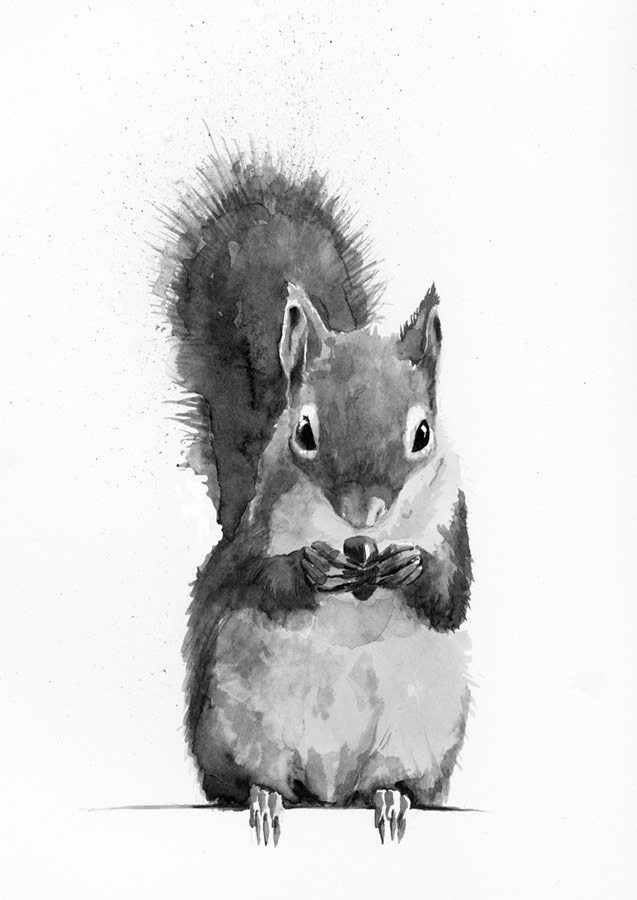
The edges between field and forest are obvious places to search for wildlife, but the transition within a forest – between softwood and hardwood stands – can be equally alive. This time of year, seek out such places to observe the often humorous interactions between red and gray squirrels.
It’s easy to root for the gray squirrels in these encounters, as their soft features are pretty universally adorable. While they’re not immune to displays of petulance, gray squirrels, for the most part, live up to their looks. Juveniles often engage in play behavior, tumbling about the crowns of oak trees with what seems like reckless abandon. They seem to be largely peaceful creatures; while there are sometimes spats over nuts, research has shown that in high-crime areas (with lots of grays competing for a limited food supply), grays will often forgo raw aggression in favor of deceptive caching, where they dig trick holes to throw off would-be nut thieves. In winter, once the caching is done, they’ll sometimes form communal nests and huddle together with their neighbors to keep warm.
Red squirrels, on the other hand, exhibit a fierce territorial streak and a loud, brash demeanor – they’re textbook bully rodents. With their bulging eyes and stout, ripped physiques, they look like smallish circus strongmen and they’re often seen chasing the much larger gray squirrel with aggressive intentions. The malice isn’t just reserved for other squirrels; who among us hasn’t been “discovered” by a red squirrel while out in the woods and been forced to endure long stretches of monotonous, aggressive shreiking?
I’ll submit that the term “badgering” should be replaced by “red squirreling” as the animal-themed term that means ‘to annoy persistently,’ as I can’t imagine that badgers come anywhere close to red squirrels in this regard.
As a general rule, red squirrels favor softwoods while gray squirrels favor hardwoods, but there is considerable play in this generalization. Some reds, for instance, are fond of “tapping” deciduous trees, especially maples, in spring – they’ll gash the bark with their incisors, then come back when the sap has evaporated to gobble up the sugars that remain on the wound. Both squirrels cache food, but reds cache in bulk, storing seeds and nuts in large piles – sometimes a bushel or more – in tree cavities and stone walls. Grays favor a more scattered approach, often distributing their buried nuts throughout a forest stand. One study showed that when storing fall-germinating, white oak acorns, grays will often excise the seed embryo before storing the nut, thus retarding the seed’s germination and extending its shelf life as a food item.
Most interesting to those with active imaginations are the tales of mass gray squirrel migrations that pop up in the historical record now and then. Extensive squirrel migrations were documented in the 1700 and 1800s; supposedly, gray squirrels swam rivers en masse and razed entire fields of crops. The last known documented migration was in 1968, when hoards of squirrels were reported throughout the eastern United States. One biologist reported that road-killed squirrels in North Carolina exceeded the normal road kill numbers that year by a factor of 1,000.
While there are various hypothesis out there to explain this behavior, including parasites and hardwired genetic impulses designed to reshuffle the gene pool, Occam’s razor (“the simplest hypothesis accounting for the most facts is most likely to be correct”) seems to suggest that the phenomenon is probably nothing more than a response to a great mast year following a bad one.
Nut trees aren’t exactly fond of squirrels – they’re trying to reproduce, after all, and the squirrels keep eating their potential offspring. To get around this problem, mast tends to come all at once, with trees of the same species synchronizing their nut production from year to year. A bumper mast year will flood a forest with nuts, ensuring that there are more nuts than squirrels to eat them. Squirrel populations will explode in response, but rather than get locked in an arms race that they won’t ever win, the trees simply stop producing nuts for a few years, causing the squirrel populations to crash. This sets the stage nicely for another mast flood a few years later.
And, indeed, mast records from the most recent migration support the idea that historical “migrations” of gray squirrels were simply caused by an overabundance of squirrels and not enough nuts, causing the animals to abandon their typical habitat in the hardwood forest and set off overland in search of food: In many areas, 1967 was an exceptional mast year, while 1968 was a notably poor one.

